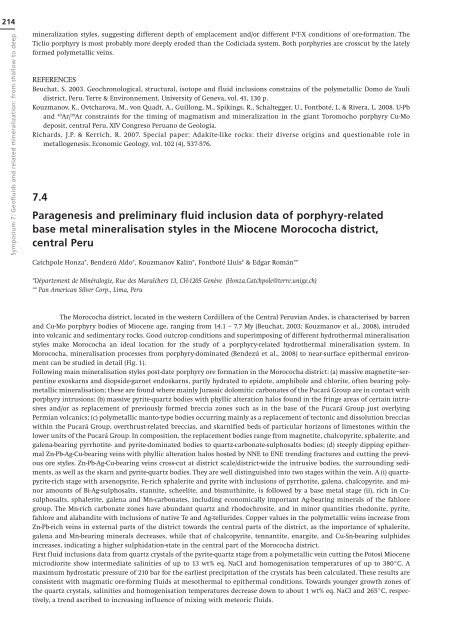Open Session - SWISS GEOSCIENCE MEETINGs
Open Session - SWISS GEOSCIENCE MEETINGs
Open Session - SWISS GEOSCIENCE MEETINGs
You also want an ePaper? Increase the reach of your titles
YUMPU automatically turns print PDFs into web optimized ePapers that Google loves.
21<br />
Symposium 7: Geofluids and related mineralization: from shallow to deep<br />
mineralization styles, suggesting different depth of emplacement and/or different P-T-X conditions of ore-formation. The<br />
Ticlio porphyry is most probably more deeply eroded than the Codiciada system. Both porphyries are crosscut by the lately<br />
formed polymetallic veins.<br />
REFERENCES<br />
Beuchat, S. 2003. Geochronological, structural, isotope and fluid inclusions constrains of the polymetallic Domo de Yauli<br />
district, Peru. Terre & Environnement, University of Geneva, vol. 41, 130 p.<br />
Kouzmanov, K., Ovtcharova, M., von Quadt, A., Guillong, M., Spikings, R., Schaltegger, U., Fontboté, L. & Rivera, L. 2008. U-Pb<br />
and 40 Ar/ 39 Ar constraints for the timing of magmatism and mineralization in the giant Toromocho porphyry Cu-Mo<br />
deposit, central Peru. XIV Congreso Peruano de Geologia.<br />
Richards, J.P. & Kerrich, R. 2007. Special paper: Adakite-like rocks: their diverse origins and questionable role in<br />
metallogenesis. Economic Geology, vol. 102 (4), 537-576.<br />
.<br />
Paragenesis and preliminary fluid inclusion data of porphyry-related<br />
base metal mineralisation styles in the Miocene Morococha district,<br />
central Peru<br />
Catchpole Honza*, Bendezú Aldo*, Kouzmanov Kalin*, Fontboté Lluís* & Edgar Román**<br />
*Département de Minéralogie, Rue des Maraîchers 13, CH-1205 Genève (Honza.Catchpole@terre.unige.ch)<br />
** Pan American Silver Corp., Lima, Peru<br />
The Morococha district, located in the western Cordillera of the Central Peruvian Andes, is characterised by barren<br />
and Cu-Mo porphyry bodies of Miocene age, ranging from 14.1 – 7.7 My (Beuchat, 2003; Kouzmanov et al., 2008), intruded<br />
into volcanic and sedimentary rocks. Good outcrop conditions and superimposing of different hydrothermal mineralisation<br />
styles make Morococha an ideal location for the study of a porphyry-related hydrothermal mineralisation system. In<br />
Morococha, mineralisation processes from porphyry-dominated (Bendezú et al., 2008) to near-surface epithermal environment<br />
can be studied in detail (Fig. 1).<br />
Following main mineralisation styles post-date porphyry ore formation in the Morococha district: (a) massive magnetite–serpentine<br />
exoskarns and diopside-garnet endoskarns, partly hydrated to epidote, amphibole and chlorite, often bearing polymetallic<br />
mineralisation; these are found where mainly Jurassic dolomitic carbonates of the Pucará Group are in contact with<br />
porphyry intrusions; (b) massive pyrite-quartz bodies with phyllic alteration halos found in the fringe areas of certain intrusives<br />
and/or as replacement of previously formed breccia zones such as in the base of the Pucará Group just overlying<br />
Permian volcanics; (c) polymetallic manto-type bodies occurring mainly as a replacement of tectonic and dissolution breccias<br />
within the Pucará Group, overthrust-related breccias, and skarnified beds of particular horizons of limestones within the<br />
lower units of the Pucará Group. In composition, the replacement bodies range from magnetite, chalcopyrite, sphalerite, and<br />
galena-bearing pyrrhotite- and pyrite-dominated bodies to quartz-carbonate-sulphosalts bodies; (d) steeply dipping epithermal<br />
Zn-Pb-Ag-Cu-bearing veins with phyllic alteration halos hosted by NNE to ENE trending fractures and cutting the previous<br />
ore styles. Zn-Pb-Ag-Cu-bearing veins cross-cut at district scale/district-wide the intrusive bodies, the surrounding sediments,<br />
as well as the skarn and pyrite-quartz bodies. They are well distinguished into two stages within the vein. A (i) quartzpyrite-rich<br />
stage with arsenopyrite, Fe-rich sphalerite and pyrite with inclusions of pyrrhotite, galena, chalcopyrite, and minor<br />
amounts of Bi-Ag-sulphosalts, stannite, scheelite, and bismuthinite, is followed by a base metal stage (ii), rich in Cusulphosalts,<br />
sphalerite, galena and Mn-carbonates, including economically important Ag-bearing minerals of the fahlore<br />
group. The Mn-rich carbonate zones have abundant quartz and rhodochrosite, and in minor quantities rhodonite, pyrite,<br />
fahlore and alabandite with inclusions of native Te and Ag-tellurides. Copper values in the polymetallic veins increase from<br />
Zn-Pb-rich veins in external parts of the district towards the central parts of the district, as the importance of sphalerite,<br />
galena and Mn-bearing minerals decreases, while that of chalcopyrite, tennantite, enargite, and Cu-Sn-bearing sulphides<br />
increases, indicating a higher sulphidation-state in the central part of the Morococha district.<br />
First fluid inclusions data from quartz crystals of the pyrite-quartz stage from a polymetallic vein cutting the Potosí Miocene<br />
microdiorite show intermediate salinities of up to 13 wt% eq. NaCl and homogenisation temperatures of up to 380°C. A<br />
maximum hydrostatic pressure of 210 bar for the earliest precipitation of the crystals has been calculated. These results are<br />
consistent with magmatic ore-forming fluids at mesothermal to epithermal conditions. Towards younger growth zones of<br />
the quartz crystals, salinities and homogenisation temperatures decrease down to about 1 wt% eq. NaCl and 265°C, respectively,<br />
a trend ascribed to increasing influence of mixing with meteoric fluids.









